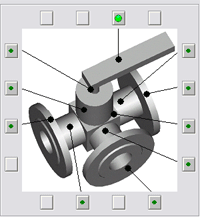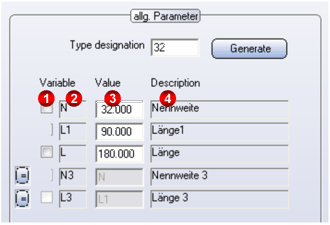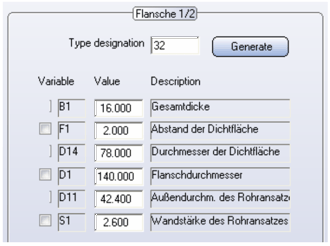Project: Variant Editor
In the combination field Value for you can select the variables group subsequently shown in the Table Box for processing. The structure description specified for the base variant, to which the current variant belongs, determines selection. These definitions are stored in the Source Definition file.
A variables group may comprise:
If you select a sub-part or a complete, assembled part, the appropriate header (or all headers) in the Preview Box, change from matt to bright.
If you select a sub-part with an On/Off capability, the program displays two buttons next to the Combination field
![]() , enabling you to toggle it On or Off. A green point on the appropriate button indicates that the part is On, while a red point indicates that it is Off.
, enabling you to toggle it On or Off. A green point on the appropriate button indicates that the part is On, while a red point indicates that it is Off.
 As simple variants do not contain part-specific groups, the combination box is only active for structured variants.
As simple variants do not contain part-specific groups, the combination box is only active for structured variants.

Example: ARM3WKHF2
The preview box displays an image of the base variant to which the loaded structured variant belongs. This is only possible if an image of the variant exists in an EMF file (Windows Enhanced Metafile) in the folder specified for Settings under Directory for the EMF files for standard variants. The EMF file must have the same name as the VAD file with the name extension .EMF.
The Show data sheet button is only activated if a data sheet for the corresponding base variant exists. It can be displayed by clicking the button This is only possible if a valid data sheet file exists in the folder specified under Settings for Directory for the EMF files for standard variants. The file must match the Type specification set under Data sheet file extension (e.g. .pdf). In addition, a suitable View program - specified under Program for data sheet viewer - must be available. The data sheet file must have the same name as the VAD file and the name extension specified under Settings.
In the illustration of a base variant, leader lines from parts point to buttons in the margin of the preview box. The coloured point on a button indicates:
|
Green |
The corresponding part is On. |
|
|
The part is Off |
|
|
The part has been selected for processing. The part data in the current record is displayed in the Table dialogue box. |
|
Red |
The corresponding part is Off. |
|
|
The part is currently deselected for processing |
|
|
The part is currently selected. The part data in the current record is displayed in the Listbox. |
Click the appropriate button to activate the appropriate part for processing. The coloured point on the button is now bright. This procedure works in the way described for selection in Select parts.
The designation of the selected variables group is in the top line of the box., e.g. General parameter. The Type designation entry field at the top of the box shows the die Type designation contained in the corresponding record. The table is comprised of four columns: Checkboxes for row selection (1), the names of variables (2), the values of variables or name of the variables, from which the value should be taken over in the same record (3), and Descriptions for variables (4):

You can define "take over" options for a variable. In the example above, this applies to variables N3 and L3: In this case, N3 should take over the Value N and L3 the value of L from the same record. This convention applies to all records belonging to the variant.
You can activate or deactivate the "take-over" with the button  .If you click the button for variable N3, the following prompt is displayed: Take over value from
N (General parameter)?
.If you click the button for variable N3, the following prompt is displayed: Take over value from
N (General parameter)?
Select Cancel to abandon changes. Select Yes to take changes over. If you select No to deactivate the "take-over", you can specify a numerical value in the entry field of the Value column.
You can also define a "take over" option for all single parts. For example:

In this case, the variables of the part Flange 3 take over the values belonging to the corresponding variables of the part Flange 1/2 in the same record. This convention applies to all records belonging to the variant.
You can activate or deactivate the "take-over" with the button ![]() The following prompt is displayed when you click the button, Take over value from "Flange
1/2" ?
The following prompt is displayed when you click the button, Take over value from "Flange
1/2" ?
Select Cancel to abandon changes, or Yes to accept them. If you select No to deactivate the "take-over", you can specify a numerical value in the entry field of the Value column.
The same option buttons as for simple variants are available at the bottom of the Table dialogue box.

The User Interface • Settings • Change/Generate Type Designation • Edit Simple Variants
|
© Copyright 1994-2020, ISD Software und Systeme GmbH |
Data protection • Terms and Conditions • Cookies • Contact • Legal notes and Disclaimer